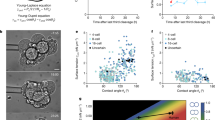Abstract
The cortical reaction at fertilization of a sea urchin egg results in the elevation of the fertilization membrane due to the exocytosis of cortical granules lying directly beneath the plasma membrane. These secretory granules are vesicles ∼1 µm in diameter and can be easily observed in phase-contrast optics. Insemination of the egg results in the release of intracellular ionized calcium which acts as the trigger for the fusion of the cortical granules with the plasma membrane and the expulsion of their contents into the extracellular space1,2. Although Ca2+is known to be involved hi exocytosis, it has not yet been clearly demonstrated how the high sensitivity to calcium is conferred on exocytosis3,4. Here we examine the action of antibodies to calmodulin on the secretion of the cortical granules and demonstrate that calmodulin is responsible for the high calcium sensitivity of the cortical reaction and can be localized on the inner plasma membrane surface.
This is a preview of subscription content, access via your institution
Access options
Subscribe to this journal
Receive 51 print issues and online access
$199.00 per year
only $3.90 per issue
Buy this article
- Purchase on Springer Link
- Instant access to full article PDF
Prices may be subject to local taxes which are calculated during checkout
Similar content being viewed by others
References
Steinhardt, R., Zucker, R. & Schatten, G. Devl Biol. 58, 185–196 (1977).
Zucker, R. & Steinhardt, R. Biochim. biophys. Acta 541, 459–468 (1978).
Rubin, P. Calcium and the Secretory Process (Plenum, New York, 1974).
Douglas, W. W. in Calcium Transport in Contraction and Secretion (eds Carafoli, E., Clementi, F., Drabiknowski, W. & Margreth, A.) 167–174 (North-Holland, Amsterdam, 1975).
Baker, P. F. & Whitaker, M. J. Nature 276, 513–515 (1978).
Baker, P. F. & Whitaker, M. J. J. Physiol., Lond. 298, 55P (1979).
Means, A. R. & Dedman, J. R. Nature 285, 73–78 (1980).
Cheung, W. Y. Science 207, 19–27 (1980).
Head, J. F., Mader, S. & Kaminer, B. J. Cell Biol. 80, 211–218 (1979).
Epel, D., Patton, C., Wallace, R. W. & Cheung, W. Y. Cell 23, 543–550 (1981).
Dedman, J. R., Welsh, M. J. & Means, A. R. J. biol. Chem. 253, 7515–7521 (1978).
Dedman, J. R., Welsh, M. J. & Means, A. R. J. biol. Chem. 252, 8415–8422 (1977).
Decker, G. L. & Lennarz, W. J. J. Cell Biol. 81, 92–103 (1979).
Martell, A. E. & Smith, R. M. Critical Stability Constants (Plenum, New York, 1974).
Author information
Authors and Affiliations
Rights and permissions
About this article
Cite this article
Steinhardt, R., Alderton, J. Calmodulin confers calcium sensitivity on secretory exocytosis. Nature 295, 154–155 (1982). https://doi.org/10.1038/295154a0
Received:
Accepted:
Issue Date:
DOI: https://doi.org/10.1038/295154a0
This article is cited by
-
Ca2+/calmodulin signals the completion of docking and triggers a late step of vacuole fusion
Nature (1998)
-
Distribution and role of calmodulin in tip growing hyphae of Saprolegnia ferax
Cell Research (1995)
-
Exocytosis reconstituted from the sea urchin egg is unaffected by calcium pretreatment of granules and plasma membrane
Bioscience Reports (1988)
Comments
By submitting a comment you agree to abide by our Terms and Community Guidelines. If you find something abusive or that does not comply with our terms or guidelines please flag it as inappropriate.



